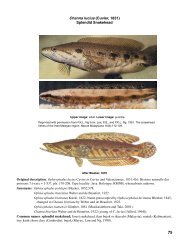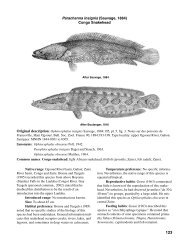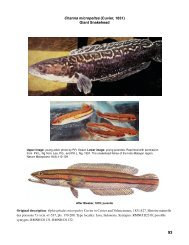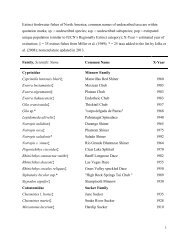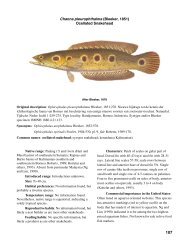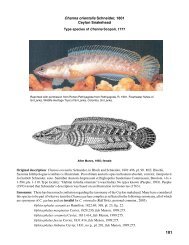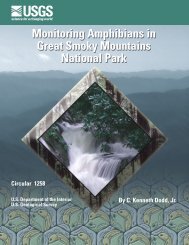Channa marulioides (Bleeker, 1851) Emperor Snakehead - USGS
Channa marulioides (Bleeker, 1851) Emperor Snakehead - USGS
Channa marulioides (Bleeker, 1851) Emperor Snakehead - USGS
- No tags were found...
Create successful ePaper yourself
Turn your PDF publications into a flip-book with our unique Google optimized e-Paper software.
<strong>Channa</strong> marulius, from Khao Laem Reservoir, Kanchanaburi Province, Thailand, June 2002. Photo courtesyof Jean-Francois Helias, Fishing Adventures Thailand.with increasing age in specimens from River Kali innorthern India. Wee (1982) cited C. marulius andC. micropeltes as the two fastest growing snakeheads.Habitat preference: Lakes and rivers; deep,clear water with sand or rocky substrate (Talwar andJhingran, 1992); “rivers usually in the vicinity of mudor fine sands” (Sen, 1985); “deep pools in rivers andoccasionally in lakes” (Pethiyagoda, 1991). Jhingran(1984) noted presence of this species in swamps, tanks(=small reservoirs), and ponds, but that it also “prefersdeep, clear stretches of water with sandy or rockybottom.” Rainboth (1996) listed preferred habitat as“sluggish or standing water in canals, lakes, andswamps from India to China, south to Thailand andCambodia.” He added that it is often found withsubmerged aquatic vegetation.Temperature range: No specific information inliterature. Native range of the species is from about34º N to 7º N, indicating a species that can exist intemperate to tropical conditions. Preliminary temperaturetesting on individuals from the established southeasternFlorida population indicated the lower range tobe about 10 ºC (Paul L. Shafland, personal commun.,2002), suggesting that this population did not originatefrom northern reaches of the native range of thisspecies.Reproductive habits: Breder and Rosen (1966)summarized brood size from Chacko and Kuriyan(1947) as being about 500 young with parents guardingthem until they reached about 10 cm in length. Eggs arepale red-yellow and 2 mm in diameter, hatch in 54 hrsat 16-26 ºC and 30 hrs at 28-33 ºC. Parameswaran andMurugesan (1976a) reported brood sizes of 357 to over3,600 in swamps in Karnataka State, India. Talwar andJhingran (1992) remarked that this species lays eggs ina nest and guards them, and that breeding occursthrough most of the year. Day (1875) supported thisguarding habit by stating, “Colonel Puckle observes‘that they are very savage, protecting their young withgreat boldness’.” Pethiyagoda (1991) noted that malesare territorial. In river basins of southern Nepal, it issaid to spawn from June until August (Shrestha, 1990).Parameswaran and Murugesan (1976a) indicatedspawning occurs in all but the months of December andJanuary in Karnataka State, India, peaking during therainy season. Jhingran (1984) stated that fecundity ofthis species is “2,000-40,000 ova.” Mirza and Bhatti(1993) indicated a spawning period in Pakistan of Aprilto June with parental protection of eggs and larvae for6 weeks. Sriramlu (1979) reported two spawning periods(May-June and November-December) for <strong>Channa</strong>marulius in Andhra Pradesh, southeastern India, ataltitudes ranging from 548 to 670 m above sea level.85



